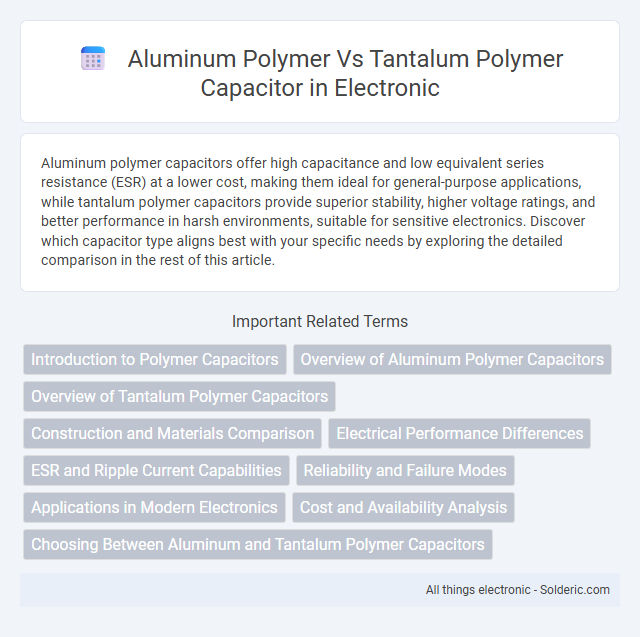Aluminum polymer capacitors offer high capacitance and low equivalent series resistance (ESR) at a lower cost, making them ideal for general-purpose applications, while tantalum polymer capacitors provide superior stability, higher voltage ratings, and better performance in harsh environments, suitable for sensitive electronics. Discover which capacitor type aligns best with your specific needs by exploring the detailed comparison in the rest of this article.
Comparison Table
| Feature | Aluminum Polymer Capacitor | Tantalum Polymer Capacitor |
|---|---|---|
| Dielectric Material | Aluminum Oxide with conductive polymer | Tantalum Oxide with conductive polymer |
| Capacitance Range | 1 uF to 1 mF | 0.1 uF to 470 uF |
| Voltage Range | 2.5 V to 100 V | 2 V to 50 V |
| Equivalent Series Resistance (ESR) | Low ESR, but higher than tantalum polymer | Very low ESR, superior for high-frequency |
| Leakage Current | Generally higher than tantalum polymer | Lower leakage current |
| Operating Temperature | -55degC to +105degC | -55degC to +125degC |
| Reliability | Good, safer during failure (non-explosive) | High reliability, but potential risk if stressed |
| Applications | Power supply smoothing, decoupling, audio circuits | High-frequency circuits, power management, medical devices |
| Cost | Lower cost | Higher cost |
Introduction to Polymer Capacitors
Polymer capacitors, including aluminum polymer and tantalum polymer types, utilize conductive polymer electrolytes to enhance performance characteristics such as low equivalent series resistance (ESR) and improved frequency response. Aluminum polymer capacitors feature a robust oxide layer on aluminum anodes, offering high capacitance in compact sizes suitable for power supply filtering and decoupling applications. Tantalum polymer capacitors, distinguished by tantalum pentoxide dielectric and conductive polymer cathodes, provide superior volumetric efficiency and stable capacitance at elevated temperatures, ideal for high-performance electronics requiring reliability and long operational life.
Overview of Aluminum Polymer Capacitors
Aluminum polymer capacitors feature a solid polymer electrolyte, offering low equivalent series resistance (ESR) and improved ripple current handling compared to traditional electrolytic capacitors. These capacitors provide high capacitance in a compact form, making them ideal for applications requiring stable performance and reliability under thermal stress. Your electronic designs can benefit from their long lifespan and excellent frequency characteristics, especially in power supply circuits and audio equipment.
Overview of Tantalum Polymer Capacitors
Tantalum polymer capacitors offer superior performance with lower equivalent series resistance (ESR) and improved frequency response compared to aluminum polymer capacitors, making them ideal for high-reliability applications. Their conductive polymer cathode enhances stability and longevity, providing excellent thermal tolerance and robust surge current capability. These capacitors are commonly used in advanced electronics such as smartphones, automotive systems, and aerospace due to their compact size and high capacitance density.
Construction and Materials Comparison
Aluminum polymer capacitors utilize a combination of an aluminum anode with a conductive polymer electrolyte, ensuring low equivalent series resistance (ESR) and high capacitance in a compact size. Tantalum polymer capacitors employ a tantalum anode paired with a conductive polymer cathode, offering superior stability and reliability under high temperature and voltage conditions. Your choice depends on the application needs, with aluminum polymer capacitors excelling in cost-effectiveness and tantalum polymer capacitors delivering enhanced performance in critical circuits.
Electrical Performance Differences
Aluminum polymer capacitors exhibit lower equivalent series resistance (ESR) and higher ripple current ratings compared to tantalum polymer capacitors, resulting in improved efficiency and thermal stability in high-frequency applications. Tantalum polymer capacitors typically offer higher capacitance per volume and better frequency response, making them suitable for miniaturized electronic devices requiring stable capacitance over time. The voltage derating in tantalum polymer capacitors is more critical due to their sensitivity to surge current, whereas aluminum polymer capacitors provide better tolerance against voltage spikes and harsh operating conditions.
ESR and Ripple Current Capabilities
Aluminum polymer capacitors typically exhibit higher Equivalent Series Resistance (ESR) compared to tantalum polymer capacitors, affecting their efficiency in high-frequency applications. Tantalum polymer capacitors generally offer lower ESR, which enhances their performance in ripple current handling and reduces heat generation. The superior ripple current capability of tantalum polymer capacitors makes them more suitable for demanding power supply circuits requiring stable voltage under variable loads.
Reliability and Failure Modes
Aluminum polymer capacitors exhibit high reliability with low equivalent series resistance (ESR) and are prone to failure modes such as electrolyte drying and dielectric breakdown under high temperatures. Tantalum polymer capacitors offer superior stability and longer lifespan with resistance to surge currents, but their failure modes include catastrophic short circuits primarily caused by voltage spikes or impurities. Both capacitor types benefit from solid polymer electrolytes, enhancing performance and reducing failure risk compared to traditional wet electrolytes.
Applications in Modern Electronics
Aluminum polymer capacitors excel in applications requiring high ripple current tolerance and long life, making them ideal for power supply circuits and consumer electronics. Tantalum polymer capacitors provide superior volumetric efficiency and stable capacitance at high frequencies, suited for space-constrained devices like smartphones and medical equipment. Both types enhance performance in modern electronics by balancing capacitance density, reliability, and operating temperature ranges.
Cost and Availability Analysis
Aluminum polymer capacitors generally offer a more cost-effective solution compared to tantalum polymer capacitors due to their widespread availability and simpler manufacturing processes. Tantalum polymer capacitors, while providing superior performance in terms of stability and reliability, tend to have higher prices and more limited supply chains influenced by the scarcity of tantalum raw materials. The overall market availability of aluminum polymer capacitors is broader, making them the preferred choice for cost-sensitive and high-volume applications.
Choosing Between Aluminum and Tantalum Polymer Capacitors
Choosing between aluminum polymer and tantalum polymer capacitors depends on your project's specific requirements such as ESR, voltage ratings, and size constraints. Aluminum polymer capacitors offer lower cost, higher ripple current capability, and better thermal stability, making them ideal for power supply filtering and decoupling applications. Tantalum polymer capacitors provide superior volumetric efficiency, stable capacitance over temperature, and enhanced reliability in space-constrained designs where long-term performance is critical.
Aluminum polymer vs tantalum polymer capacitor Infographic

 solderic.com
solderic.com